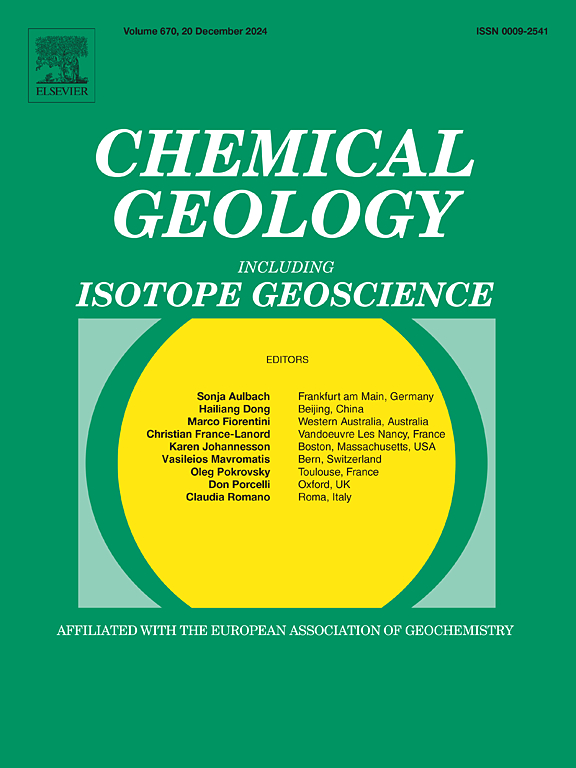Subducted ophicarbonates as source for B-bearing diamond formation
IF 3.6
2区 地球科学
Q1 GEOCHEMISTRY & GEOPHYSICS
引用次数: 0
Abstract
This study presents in-situ B isotope compositions (δ11B) of antigorite from well-characterized ophicarbonates that underwent prograde to high-pressure (high-P) metamorphic evolution during the Alpine orogeny (300–500 °C and 0.6–2.3 GPa). The δ11B values in antigorite are highly variable, ranging from ca. -8 to +7 ‰. Coupled with in-situ 87Sr/86Sr ratios of carbonates (ranging from 0.7065 to 0.7085), this B isotope variability may reflect either inherited oceanic imprints or re-equilibration with metamorphic fluids during subduction processes. These interpretations are further corroborated by in-situ REE and incompatible trace element data on antigorite. The devolatilization and densification of slab lithologies during subduction drive the recycling of slab and wedge materials into the Earth's mantle, contributing to its chemical heterogeneity. Remarkably, the δ11B signatures of antigorite reported here overlap with the variability observed in B-bearing diamonds formed at transition zone/lower mantle depths, as well as in carbonatites and ocean island basalts (OIBs), suggesting a geochemical connection. Together with literature data, this study proposes that deeply subducted ophicarbonates may transform into carbonate-bearing secondary peridotites with geochemical features compatible with B-bearing diamonds. Deeply subducted ophicarbonates, with enriched trace element and isotopic signatures, may also act as reservoirs influencing mantle dynamics and the geochemical diversity of OIB and carbonatite mantle sources. These findings provide new constraints into the recycling of B and volatiles at convergent margins, extending to depths compatible with the lower mantle region.
俯冲的油碳酸盐岩是含硼金刚石地层的来源
本文研究了高寒造山运动(300 ~ 500℃,0.6 ~ 2.3 GPa)期间,经过高压(高磷)变质演化的富碳酸盐反长花岗岩的原位B同位素组成(δ11B)。反长岩的δ11B值变化很大,在-8 ~ +7‰之间。结合原位碳酸盐87Sr/86Sr比值(0.7065 ~ 0.7085),这种B同位素变异可能反映了继承的海洋印记或在俯冲过程中与变质流体的再平衡。这些解释得到了反长岩原位稀土元素和不相容微量元素数据的进一步证实。俯冲过程中,板块岩性的脱挥发和致密化促使板块和楔块物质向地幔循环,形成了地幔的化学非均质性。值得注意的是,本文报道的反长花岗岩的δ11B特征与在过渡带/下地幔深处形成的含b钻石以及碳酸盐岩和洋岛玄武岩(OIBs)中观察到的变异性重叠,表明两者具有地球化学联系。结合文献资料,认为深俯冲的蛇碳酸盐可能转化为含碳酸盐次生橄榄岩,其地球化学特征与含硼金刚石相匹配。深俯冲的油碳酸盐岩具有丰富的微量元素和同位素特征,也可能是影响地幔动力学和OIB和碳酸盐岩地幔源地球化学多样性的储层。这些发现对辐合边缘的B和挥发物的再循环提供了新的限制,并延伸到与下地幔区域相容的深度。
本文章由计算机程序翻译,如有差异,请以英文原文为准。
求助全文
约1分钟内获得全文
求助全文
来源期刊

Chemical Geology
地学-地球化学与地球物理
CiteScore
7.20
自引率
10.30%
发文量
374
审稿时长
3.6 months
期刊介绍:
Chemical Geology is an international journal that publishes original research papers on isotopic and elemental geochemistry, geochronology and cosmochemistry.
The Journal focuses on chemical processes in igneous, metamorphic, and sedimentary petrology, low- and high-temperature aqueous solutions, biogeochemistry, the environment and cosmochemistry.
Papers that are field, experimentally, or computationally based are appropriate if they are of broad international interest. The Journal generally does not publish papers that are primarily of regional or local interest, or which are primarily focused on remediation and applied geochemistry.
The Journal also welcomes innovative papers dealing with significant analytical advances that are of wide interest in the community and extend significantly beyond the scope of what would be included in the methods section of a standard research paper.
 求助内容:
求助内容: 应助结果提醒方式:
应助结果提醒方式:


